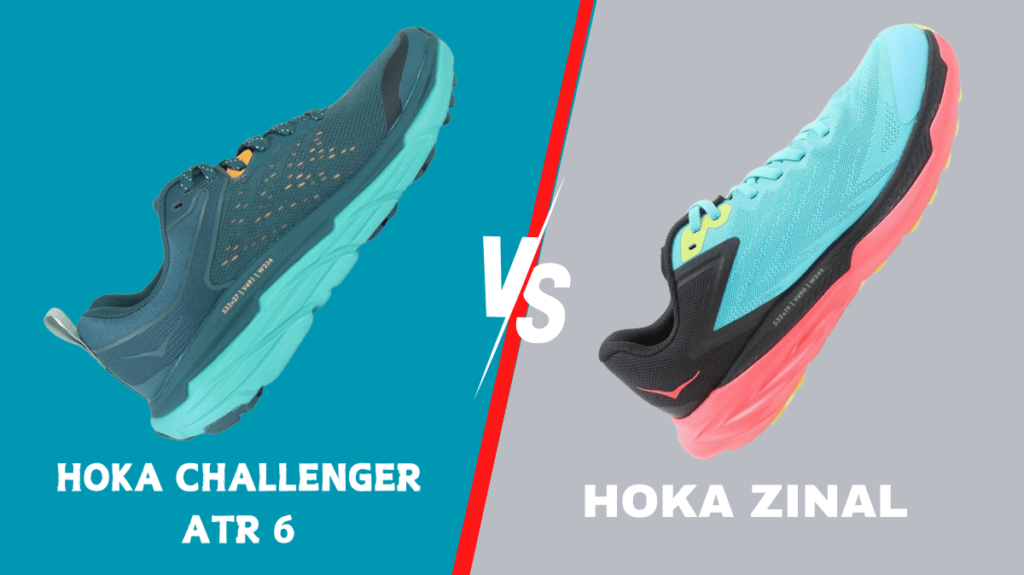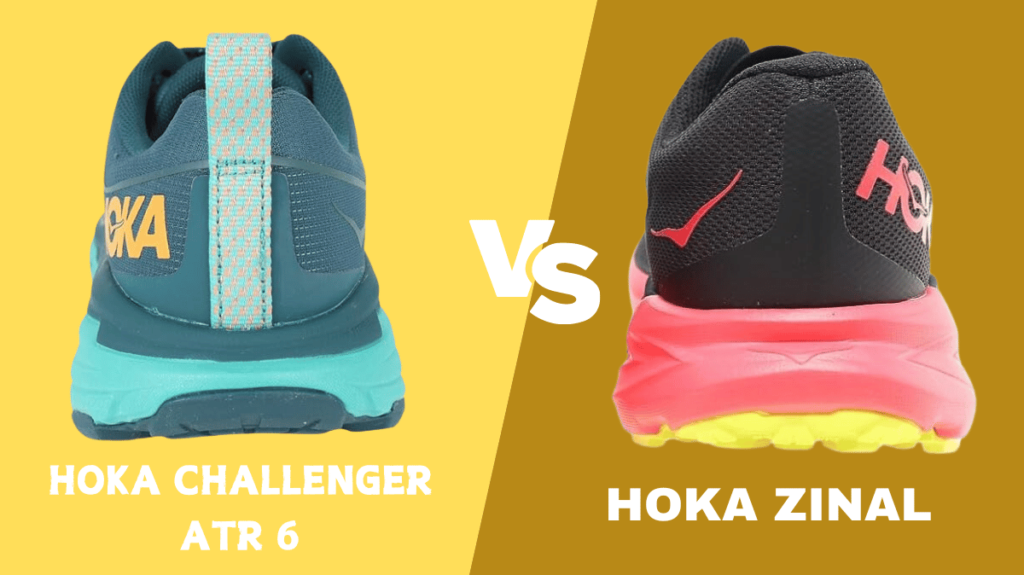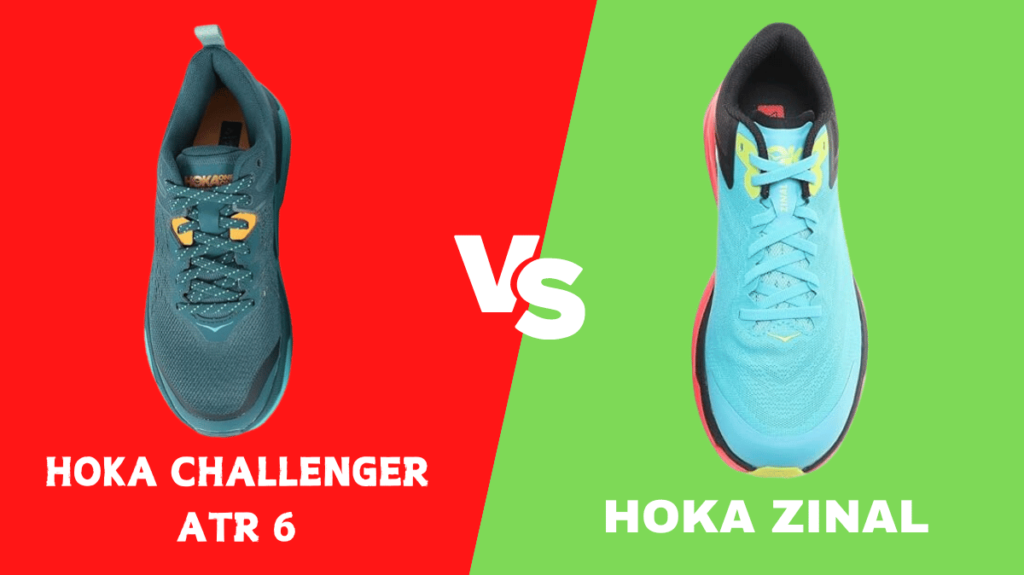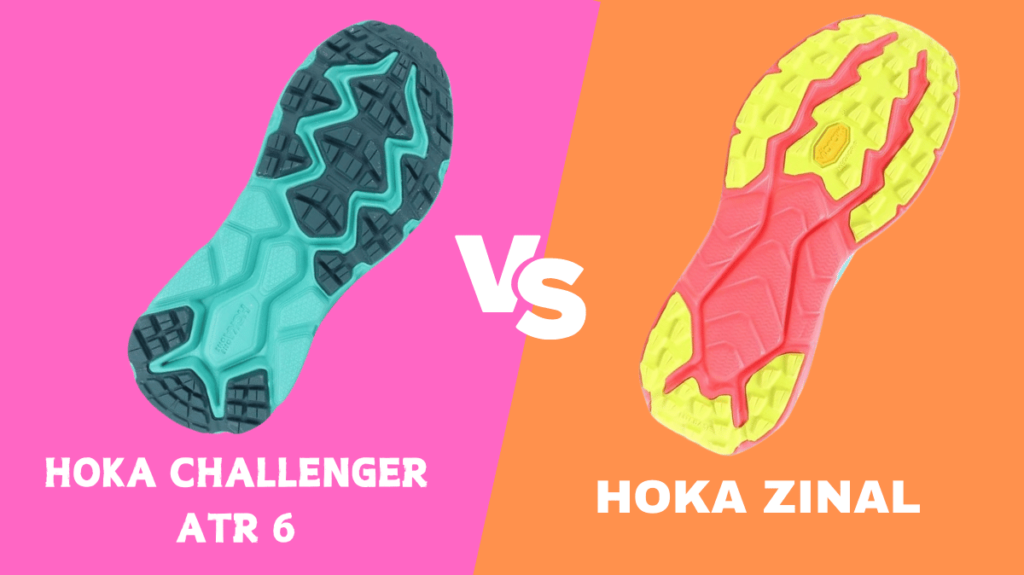Physical Address
304 North Cardinal St.
Dorchester Center, MA 02124
Physical Address
304 North Cardinal St.
Dorchester Center, MA 02124
Choosing the right trail running shoe can make a significant difference in your running experience. Among the popular choices are the Hoka Challenger ATR 6 vs Hoka Zinal. Both shoes offer unique features tailored for different running needs. This comprehensive guide will delve into a detailed comparison of these two models, covering their comfort, style, design, and other critical aspects to help you make an informed decision.

| Feature | Hoka Challenger ATR 6 | Hoka Zinal |
| Design | Versatile, designed for road and trail | Sleek, minimal design focused on speed |
| Comfort | High comfort, cushioned | Comfortable with a responsive feel |
| Fit | True to size, roomy toe box | Snug fit, designed for performance |
| Breathability | Good breathability | Excellent breathability |
| Durability | Durable, designed for various terrains | Durable for racing, but less robust for everyday trail use |
| Weight | 9.8 oz (Men’s) | 8.5 oz (Men’s) |
| Price Range | $130 – $140 | $160 – $170 |
| Color Options | Multiple colorways | Limited colorways |
The Hoka Challenger ATR 6 is a versatile trail running shoe that excels on a variety of surfaces. It’s designed to provide a balanced combination of comfort and durability, making it suitable for both novice and experienced trail runners.
The Hoka Zinal is built with speed and agility in mind. It is lighter than the Challenger ATR 6 and designed for technical trails, offering a more responsive feel.
The Hoka Challenger ATR 6 is renowned for its plush cushioning. The shoe’s midsole is engineered to absorb shock effectively, reducing the impact on your joints. This is particularly beneficial for long-distance runners or those who frequently encounter rugged terrain. The shoe also features a roomy toe box, which allows your toes to spread out comfortably. This can be a significant advantage during long runs when your feet may swell.
The Hoka Zinal, while also comfortable, offers a different type of cushioning experience. The shoe is designed to be lighter and more responsive, providing a faster rebound and better ground feel. This can be advantageous for runners who prioritize speed and agility. However, the cushioning may not be as plush as that of the Challenger ATR 6, making it less ideal for very long runs or those who need extra shock absorption.

The Hoka Challenger ATR 6 features a more traditional trail running shoe design. It has a wider midsole and a rugged outsole that is designed to handle various types of terrain. The shoe’s overall appearance is practical and functional, with a focus on durability and comfort.
The Hoka Zinal has a sleek, modern design that reflects its focus on speed and agility. It is lower to the ground compared to the Challenger ATR 6, which enhances its responsiveness and agility.
Here’s a quick comparison of the key differences between the Hoka Challenger ATR 6 and the Hoka Zinal:
| Feature | Hoka Challenger ATR 6 | Hoka Zinal |
| Cushioning | Plush and cushioned | Light and responsive |
| Design | Traditional, rugged | Sleek, modern |
| Weight | Heavier, more cushioned | Lighter, more agile |
| Fit | Roomy toe box | Snug, secure |
| Outsole | Multi-pattern for varied terrain | Grippy, designed for technical trails |
The Hoka Challenger ATR 6 is generally true to size. It offers a bit of extra room in the toe box, which can be beneficial for long-distance runs. Runners who are between sizes may find it helpful to try on the shoes or refer to sizing guides provided by Hoka.
The Hoka Zinal is also true to size but has a more precise fit. This snug fit helps to secure your foot in place, which is advantageous for technical trails. Runners with wider feet might consider going a half size up to ensure a comfortable fit.
Hoka One One is well-known for producing high-quality running shoes that cater to various running needs. Both the Challenger ATR 6 and the Zinal have received positive feedback from the running community, each for different reasons.

The Challenger ATR 6 features a breathable mesh upper that allows for good airflow. This helps keep your feet cool and dry, which is important during long runs or in warmer conditions. The mesh material also contributes to the shoe’s overall comfort.
The Zinal also has a breathable upper, but its design is more focused on lightweight performance. The mesh allows for adequate ventilation, helping to maintain comfort during faster-paced runs or technical trails.
The Hoka Challenger ATR 6 is built to last with its rugged outsole and reinforced upper. The shoe is designed to withstand rough and varied terrains, making it a durable option for frequent trail runners. Its robust construction ensures that it can handle the demands of long-distance running and challenging trails.
While the Zinal is also durable, it is designed to be lighter, which might affect its longevity compared to more rugged models. It is built to handle technical trails but may not be as durable on very rough surfaces or for extremely long distances.
The Challenger ATR 6 offers a generous fit with good arch support. The roomy toe box allows for natural foot movement, which is beneficial for long runs. The shoe provides ample cushioning and support, making it suitable for runners who need extra comfort over extended distances.
The Zinal provides a snug fit with excellent support for quick maneuvers. Its design ensures that your foot stays secure, which is important for navigating technical trails. The shoe’s support system is geared towards agility and responsiveness rather than long-term cushioning.
| Model | Average Price (USD) |
| Hoka Challenger ATR 6 | $140 – $160 |
| Hoka Zinal | $130 – $150 |
The Hoka Challenger ATR 6 is generally priced slightly higher than the Zinal, reflecting its additional cushioning and rugged design. The Zinal, being a lighter and more responsive shoe, is priced competitively and may offer better value for runners focused on speed and agility.

Both the Hoka Challenger ATR 6 and the Hoka Zinal have their strengths, making them suitable for different types of runners. If you’re looking for a trail shoe that offers superior cushioning and durability for long runs, the Challenger ATR 6 is an excellent choice. Its plush comfort and rugged design make it a versatile option for varied terrains.
On the other hand, if you prioritize speed and agility on technical trails, the Hoka Zinal is worth considering. Its lightweight and responsive design enhance performance and maneuverability, making it ideal for fast-paced trail running.
Ultimately, the best choice will depend on your specific running needs and preferences. Both shoes are high-quality options from a reputable brand, so you can’t go wrong with either. Consider your priorities—whether it’s cushioning, responsiveness, or durability—to make the best decision for your trail running adventures.
The Hoka Zinal is better suited for technical trails due to its lightweight design and responsive cushioning, which enhance speed and agility on uneven surfaces.
Both shoes generally run true to size, but the Challenger ATR 6 has a roomier fit, while the Zinal offers a more snug and secure fit. Runners with wider feet might find the Challenger ATR 6 more comfortable.
While both models are designed primarily for trail running, the Hoka Challenger ATR 6 is more versatile and can handle some road running. The Zinal is more specialized for trail use and may not be as comfortable on hard surfaces.
The Hoka Challenger ATR 6 is typically priced between $140 and $160, while the Hoka Zinal ranges from $130 to $150. The Challenger ATR 6 is generally more expensive due to its additional cushioning and rugged design.
Customer reviews highlight the Challenger ATR 6 for its comfort and durability, making it a great choice for long-distance runs. The Zinal is praised for its lightweight and agility, ideal for quick, technical trails. Each shoe excels in different aspects, so the best choice depends on your specific needs.